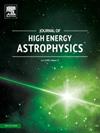Einstein-Gauss-Bonnet cosmology confronted with observations
IF 10.5
4区 物理与天体物理
Q1 ASTRONOMY & ASTROPHYSICS
引用次数: 0
Abstract
Several models within the framework of Einstein-Gauss-Bonnet gravities are considered with regard their late-time phenomenological viability. The models contain a non-minimally coupled scalar field and satisfy a constraint on the scalar field Gauss-Bonnet coupling, that guarantees that the speed of the tensor perturbations is equal to the speed of light. The late-time cosmological evolution of these Einstein-Gauss-Bonnet models is confronted with the observational data including the Pantheon plus Type Ia supernovae catalogue, the Hubble parameter measurements (cosmic chronometers), data from cosmic microwave background radiation (CMB) and baryon acoustic oscillations (BAO) including the latest measurements from Dark Energy Spectroscopic Instrument (DESI). Among the considered class of models some of them do not fit the CMB and BAO data. However, there exists some models that generate a viable Einstein-Gauss-Bonnet scenario with well-behaved late-time cosmological evolution that fits the observational data essentially better in comparison to the standard Λ-Cold-Dark-Matter model.
爱因斯坦-高斯-邦纳宇宙学面对观测
在爱因斯坦-高斯-邦尼引力框架内的几个模型考虑了它们的后期现象学可行性。该模型包含一个非最小耦合标量场,并满足标量场高斯-邦尼特耦合的约束,保证张量摄动的速度等于光速。这些爱因斯坦-高斯-博内模型的晚时间宇宙学演化与观测数据(包括万神殿+ Ia型超新星目录)、哈勃参数测量(宇宙天文钟)、宇宙微波背景辐射(CMB)数据和重子声学振荡(BAO)数据(包括暗能量光谱仪器(DESI)的最新测量数据)相结合。在考虑的模型类别中,有些模型不适合CMB和BAO数据。然而,有一些模型产生了一个可行的爱因斯坦-高斯-邦尼特情景,与标准的Λ-Cold-Dark-Matter模型相比,它具有良好的晚时间宇宙演化,本质上更符合观测数据。
本文章由计算机程序翻译,如有差异,请以英文原文为准。
求助全文
约1分钟内获得全文
求助全文
来源期刊

Journal of High Energy Astrophysics
Earth and Planetary Sciences-Space and Planetary Science
CiteScore
9.70
自引率
5.30%
发文量
38
审稿时长
65 days
期刊介绍:
The journal welcomes manuscripts on theoretical models, simulations, and observations of highly energetic astrophysical objects both in our Galaxy and beyond. Among those, black holes at all scales, neutron stars, pulsars and their nebula, binaries, novae and supernovae, their remnants, active galaxies, and clusters are just a few examples. The journal will consider research across the whole electromagnetic spectrum, as well as research using various messengers, such as gravitational waves or neutrinos. Effects of high-energy phenomena on cosmology and star-formation, results from dedicated surveys expanding the knowledge of extreme environments, and astrophysical implications of dark matter are also welcomed topics.
 求助内容:
求助内容: 应助结果提醒方式:
应助结果提醒方式:


